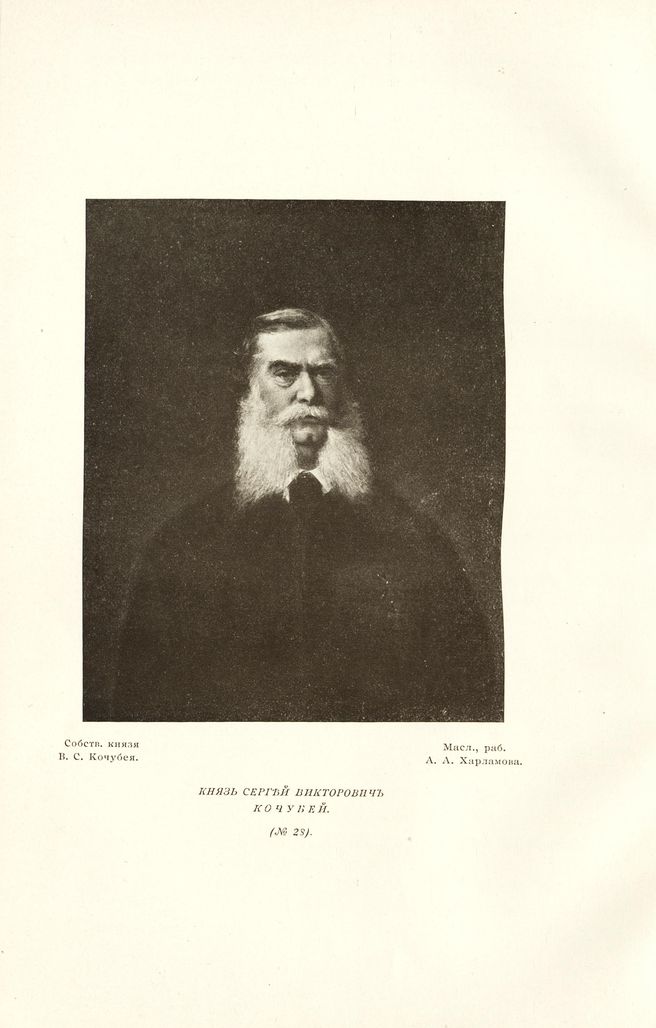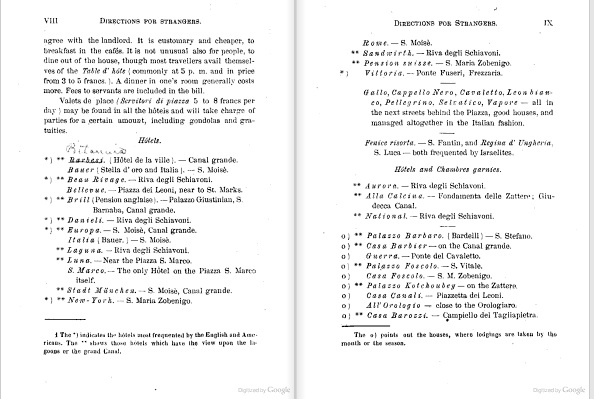
Guide book: Venice Her Art-Treasures and Historical Associations
A Guide to the city and the neighboring Islands.
Translated from the third German Edition of Adalbert Mueller
A page from an 1873 German guide book offers the Palazzo Kotchoubey for rent. This large house or palazzo in Venice is hidden behind a high wall and from the top floors it is possible to see the Giudecca Canal flowing by the wide street that separates the house from the canal. Behind the walls and through the door on the Zattere is a rare and beautiful garden. The city with its canals and houses all competing for space has little tolerance for gardens but here on the southern island is a small luxury that breaks the rhythms of the city centre. Two buildings are seamlessly integrated, one brick and one stucco. It leaves one with the impression that the house is a deliberate 19th century confection of old and new fused together. Among its unique features from the outside, is its ironwork which holds up a second floor balcony at one end of the building. The current owners tell their guests that it is was made and imported from St. Petersburg. Beyond the old trees and the scented flowers, in a corner of the garden, against the wall is the handsome marble bust of a gentleman. He is portrayed wearing the typical clothing of the 1860s or 1870s and it may very well be the bust of prince Prince Sergei Victorovitch Kotchoubey / Сергей Викторович Кочубей (1820 -1880), the owner who gave his name to the building.

The palace passed through the family’s ownership for only a brief period but it was an important place as it gave birth and took life from one generation of Kotchoubeys. Russians aristocratic families began to own many houses in Europe and by the mid 19th century, Russians families were prominently established in all the major European countries. The fact that the palace was owned by the Kotchoubeys was unusual in that Venice was not a typical destination for Russians in Europe. It is therefore most likely that the home was purchased by Prince Sergei because of his wife Princess Sophia Alexandrovna (née countess Benkendorff) / Софья Александровна Бенкендорф (Демидова, Кочубей) (1825 -1875). Certainly, Venice was an essential stop on any proper tour of Europe but the decision to buy a palace in Venice will have come through the connections from Princess Sophia’s first husband, Prince Pavel Grigorovitch Demidov /Павел Григорьевич Демидов (1809 -1858). He was a member of a fabulously rich, aristocratic, industrialist family called the Demidovs. The Demidovs were not only rich by Russian standards (some historians believe they were the richest Russian family of the era, having even surpassed the Cheremeteffs) but the easily ranked among the wealthiest families in Europe. In addition, Prince Sergei’s sister, Countess Natalia Viktorovna (nee Princess Kotchoubey) was married to Count Alexander Grigorievitch Stroganov / Александр Григорьевич Строганов (1795 – 1891) a member of another fabulously wealthy family. His paternal aunt, Princess Elizaveta Alexandrovna Demidova (nee Countess Strogonova) / Елизавета Александровна Строганова (Демидова)(1778-1818) was married to Prince Nikolai Nikitievitch Demidov / Николай Никитич Демидов (1773-1828) who died in Florence, Italy. Their son and Prince Pavel’s cousin was Prince Anatoly Nikolaievich Demidov, 1st Prince of San Donato / Анатолий Николаевич Демидов; (1813 -1870) who in addition to being a great patron of buildings and the arts in Italy, was for a brief time a diplomat in Venice. With the family connection via the Demidovs and the seduction of the city’s palaces and waterways, Russians who had grown up in St. Petersburg, another city of palaces and waterways and appropriately known as the Venice of the north would have felt right at home. In the 1850s, after Prince Sergei finished his tour of Europe and settled down in Russia, the palace came into the family’s possession.

Within a few years at the start of the 1860s, Venice witnessed the brightest presence of the Kotchoubeys in the city. Princess Sophia gave birth to one of her three sons in Venice. Of the two surviving sons, they were distinguished by carrying the princely family line into the 20th century. This was hardly an accomplishment since by the 1950s it became clear that they were both the fathers of the last of the Princely Kotchoubey descendants. As was a common occurence in 19th century Europe, their eldest son, Prince Leonti Sergeievitch / Леонтий Сергеевич Кочубей, (1861 -1865) was born in 1861 but died in childhood at the age of four. On the 9th of February, 1862, their second son, Prince Vassili Sergeievitch /Василий Сергеевич Кочубей, (1862-1911) was born in Venice. This was an appropriate place for the future Cassanova to be born, as later in his life he tore through Europe’s great capitals and tabloids with a flurry of scandal and exquisite living.
Shortly after the wedding in Paris in 1858 of Prince Sergei’s cousin, Nikolai Arkadievitch / Николай Аркадьевич Кочубей (1827 -1865) the prince and princess welcomec Nikolai and his second wife, Elena Sergeievna (née princess Volkonskaya) / Елена Сергеевна Волконская (1835-1916) to Venice on their honeymoon. Prince Sergei and Sophia were present at their wedding and as they were friends with Nikolai’s brother Vassili Arkadievitch (1826-1897) the happy reunion was another reminder ofthe friendships that blossomed among cousins. Only a decade earlier from 1850-1851, the cousins Prince Sergei and Vassili embarked on a European tour together and became fast friends.
Nikolai was not lucky in his marriages. Having lost his first wife to breast cancer after only a few years of marriage, this time with his second wife, he was the one to fall ill. Perhaps at the urging of his brother Vassili or that of Prince Sergei, Nikolai returned back to Venice only a few years later in 1863 to his cousin’s house to recuperate from tuberculosis. Without any progress for curing the dreaded disease, it was thought that a change in climate and the humid air of Venice might alleviate the symptoms or even send the disease into remission. After spending around two years in Venice, where he was far from his family and his young son, he died on his birthday in 1865. The move to Venice was in vain.
Nikolai’s distant uncle, Prince Piotr Andreevich Wiazemsky / Пётр Андреевич Вяземский (1792-1878), a renowned poet and Alexander Pushkin’s classmate memorialised his friendship with Nikolai with a poewm he wrote on Venice in 1863 when he himself moved to Baden Baden due to his own poor health. Whether it wax dedicated in 1863 or posthumously after his death in 1865, the poem to Nikolai Arkadievitch is below:
Николаю Аркадьевичу Кочубею
Венеция прелесть, но солнце ей нужно,
Но нужен венец ей алмазов и злата,
Чтоб всё, что в ней мило, чтоб всё, что там южно,
Горело во блеске без туч и заката,
Но звёзды и месяц волшебнице нужны,
Чтоб в сумраке светлом, чтоб ночью прозрачной
Серебряный пояс, нашейник жемчужный
Сияли убранством красы новобрачной.
А в будничном платье под серым туманом,
Под плачущим небом, в тоске дожденосной
Не действует прелесть своим талисманом,
И смотрит царица старухой несносной.
Не знаешь, что делать в безвыходном горе.
Там тучи, здесь волны угрюмые бродят,
И мокрое небо, и мутное море
На мысль и на чувство унынье наводят.
Под этим уныньем с зевотой сердечной,
Другим Робинсоном[1] в лагунной темнице,[2]
Сидишь с глазу на глаз ты с Пятницей[3] вечной,
И тошных семь пятниц сочтёшь на седмице.[4]
Тут вспомнишь, что метко сказал Завадовский,[5]
До прозы понизив морскую красотку:
«Здесь жить невозможно, здесь город таковский,
Чтоб в лавочку сбегать — садися ты в лодку».
27 октября 1863
Венеция

